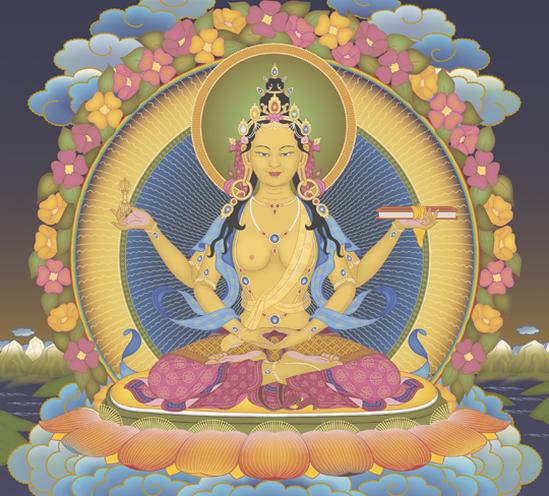Avalokitesvara is a Buddha who embodies the compassion of all Buddhas. He is variably depicted, described, and portrayed in different cultures as either male or female. In Tibet, he is known as Chenrezig. In East Asia, he is commonly known as Guanyin, the Goddess of Mercy.
The meaning of Avalokitesvara means “Lord who looks down with compassion.” Avalokiteshvara is shown here sitting on a lion throne and arrayed in jewels like a prince. Above his head is a parasol, an ancient symbol of royal status.
Beside his head are lotus-borne stupas, topped with sun and crescent moons. Avalokiteshvara’s right hand is in the gesture of gift-granting, and in his left hand he holds a long-stemmed lotus.In his elaborate hairdress is an image of the Buddha, Amitabha. Amitabha presides over the western Pure Land, a kind of Buddhist paradise. The worship of Amitabha became very popular in East Asian Buddhism.
What is the symbolism of Avalokiteshvara?The tantric power and forthright majesty of Eleven-headed Avalokiteshvara radiate laser-like focused energy. The eyes exhibit the fierce concentration created by advanced tantric practices. This Chenrezig will burn through all obstacles.
Thousand Arms thousand eyes AvalokiteshvaraThe Buddhist pantheon consists of a vast array of deities, beginning with the historical Buddha Shakyamuni and expanding to include Bodhisattvas, guardian figures, wrathful deities, and more. This painting depicts the Thousand-armed and Thousand-eyed Avalokiteshvara surrounded by attendant and guardian deities.
Avalokiteshvara, one of the most important Bodhisattvas in Buddhism, was popularly known as the “perceiver of the world’s cries.” Bodhisattvas, meaning literally “enlightened beings,” were devoted, out of a deep sense of compassion, to aiding other sentient beings in their quest for enlightenment.
The largest of the arms, located closer to the body, hold implements such as a sutra, mirror, water vessel, alms bowl, and willow spray. Inside the Bodhisattva’s elaborate headdress is a tiny figure of Amitabha, the Buddha of the Western Pure Land with whom Avalokiteshvara was associated.
Avalokiteshvara dedicated himself to helping all sentient beings toward enlightenment, but after he learned of the vast amount of suffering in the world, his head split into pieces. Amitabha gathered these 11 pieces, turned each into a full head, and gave these heads back to Avalokiteshvara.
What does Chenrezig mean in Tibetan culture?
One who always looks upon all. In Tibetan, Avalokiteśvara is Chenrezig. The etymology of the Tibetan name Chenrezig is spyan "eye," ras "continuity," and gzig "to look." This gives the meaning of one who always looks upon all beings (with the eye of compassion).
Why is Chenrezig known as the Buddha of compassion?
Chenrezig is a Buddha who symbolizes the compassion of all the Buddhas. He vowed himself that he would not rest until all beings entered Nirvana.
In that process, he takes a vow: “May I be able to establish in emancipation all the living beings in the cruel Land of Snow, where beings are so hard to discipline and none of the Buddhas of the three times has stepped out.
I may be able to mature and liberate them, each according to his way. May that gloomy, cruel country become bright, to the island of precious jewels." and takes a form with 1000 arms, 1000 eyes, and 11 heads to see and help everyone who is needed.
Meaning of ChengrezigThe meaning of the word chengrezig is CHAN means "eye, RE means “idea of continuity, and ZIG means ‘to look." He is one of the celebrated deities, and he was the lord gifted with complete enlightenment who refrains from entering the blissful state of nirvana to remain below and save the living being of the earth.
He is visualized in many forms, with various numbers of faces armed and with various colors and ornaments. He is four-armed Chenrezig; his two arms are joined in the prayer position, and his left arm is holding a lotus flower, and his right hand is holding a crystal mala (rosary).
He used to count that rosary and repeat his mantra, “Om Mani Padme Hum." He is the Boddhisattva of boundless compassion, which is the very embodiment and realization of the four immeasurable hands and arms signed of his.
Donations for our Buddhist research and development.





























